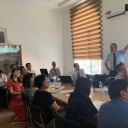The second stage of the 3rd Scientific Expedition of the Lublin University of Technology to Central Asia was Tashkent – the capital of Uzbekistan. Employees of the Institute of Computer Science – participants of the expedition, in the persons of Prof. Jerzy Montusiewicz, Dr. Marek Miłosz, and Dr. Jacek Kęsik, scanned artefacts at the National Museum of the History of Uzbekistan. Probably the most interesting artefact in this museum is a stone sculpture – an altar, depicting the Buddha surrounded by praying monks. Stone Buddha is dated to the 1st-3rd century and was found in the Fayaztepa area in the village of Stary Termez. Work in the museum was possible thanks to the support of the museum managers: Prof. Zhannat Ismailova and Prof. Otabek Aripdjanov. During the expedition, 3D scans of 32 objects in the museum were made, acquiring over 30 GB of data. The oldest scanned artifact (clay pot) was about 7,000 years old.
The team also took part in a seminar at the Uzbek Academy of Sciences. The topic of the seminar was “3D technologies in cultural heritage”. During it, the technologies used during the expeditions of the Lublin University of Technology, the results so far and contribution to the popularization of the Central Asia region through the multimedia exhibition were presented. The “3D Digital Silk Road” portal was also presented (silkroad3D.com). The Academy of Sciences of Uzbekistan has placed a report about seminar on its website (http://tmarkaz.uz/?p=1898&lang=ru). Contacts have been established with the employees of the Academy, in particular with prof. Mirzokhid Rakhimov and his team. The seminar was organized by Aziz Mullaev, PhD student at the academy.
